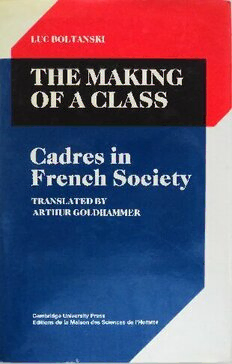
The Making of a Class: Cadres in French Society PDF
Preview The Making of a Class: Cadres in French Society
THE MAKING OF A CLASS Cadres in French Society LUC BOLTANSKI Translated b^Aæt'hur Goldhammer The right of the University of Cambridge to print and sell all manner of books was granted by Henry VIII in 1534. The University has printed and published continuously since 1584. Cambridge University Press Cambridge New York New Rochelle Melbourne Sydney Editions de la Maison des Sciences de L’Homme Paris Published by the Press Syndicate of the University of Cambridge The Pitt Building, Trumpington Street, Cambridge CB2 2RP 32 East 57th Street, New York, NY 10022, USA 10 Stamford Road, Oakleigh, Melbourne 3166, Australia Originally published in French as Les cadres: La formation d’un groupe sociale by Les editions de minuit, Paris, 1982 and © Les editions de minuit, 1982 First published in English in 1987 by the Cambridge University Press and the Maison des Sciences de PHomme as The Making of a Class: Cadres in French Society English translation © Maison des Sciences de l’Homme and Cambridge University Press 1987 Printed in Great Britain by Redwood Burn Limited, Trowbridge, Wiltshire British Library cataloguing in publication data Boltanski, Luc The making of a class: cadres in French society. 1. Middle classes - France - History 2. France - Social life and customs - 19th century 3. France - Social life and customs - 20th century I. Title IL Les Cadres. English 944.08'0880622 DC33.6 Library of Congress cataloguing in publication data Boltanski, Luc. The making of a class. Translation of: Les cadres. Bibliography. Includes index. 1. Social classes - France. I. Title. HN440.S6B6513 1987 305.5'0944 87-5213 ISBN 0 521 32073 9 ISBN 2 7351 0200 9 (France only) For Rosine Contents Abbreviations and acronyms page x Translator’s introduction xiii Preface xv Introduction 1 : one man’s story 1 “I am a cadre” 1 The meaning of the tale 7 The “sales engineer” 11 The years of apprenticeship 14 The state of uncertainty 17 The company 19 Introduction 2: a question of sociology 2 7 Provisional description 27 The word and the thing 28 The “proper form” of a group 31 Part 1 The invention of cadres 37 1 The crisis of the 1930s and the mobilization of the middle class 37 Phase one: the middle-class movements 38 Third party and third way 49 What is the middle class? 54 Rising and declining segments 62 Two meanings of the opposition to capitalism 69 A magnetic pole: the engineers 74 The Vichy government 79 The C GC and nostalgia for corporatism 83 The resurrection and death of the middle class 89 vii Contents Toward a new bourgeois household economy 92 2 The fascination with the United States and the importation of management 97 The “productivity missions” to the United States 98 “America, Youth, Success, Beauty, the Future” 103 The second “third way”: from corporatism to the New Deal 106 L1 Express'. “the magazine for cadres” 111 The industry of management 117 Group dynamics versus totalitarianism 126 “The conversion of the entire world” 131 The rationalization of careers 135 The new moral economy 137 A successful group 142 Part 2 A finished group 145 3 The field ofrepresentations 145 The mobilization of sociologists 148 Double dependency 151 Legalism and the obsession with boundaries 156 Hard-liners 160 The invention of the “new working class” 162 “New working class” or “classless society”? 167 Scientifi c representations and union representations 170 “Social art” and “social science” 180 4 The university and business 184 A new dogma: investment in education 184 From scarcity to overproduction 188 Competence and skill 193 Public and private 197 The value ofa diploma 203 Right-wing cadres and left-wing cadres 208 The “modernization” of the university 215 The Sorbonne in the 1960s 218 The working bourgeoisie 221 5 Careers 227 A heterogeneous space 227 Characteristics of firms and social attributes of cadres 231 Cadre or boss? 235 The vulgarization of the “cadre” title 245 Career uncertainties 247 Processes of exclusion 257 Integration rituals 264 The institutionalization of autodidactism 269 A pathology of “promotion” 273 viii Contents Conclusion: The cohesion of a fluid group 279 The most “cadre-like” of “cadres” 279 Differences and divisions 284 The interaction ofreciprocal images 286 The strength of weak aggregates 291 The authentic and the inauthentic 293 Epilogue: the car in the garage 297 Notes 306 Principal statistical sources 383 Index 386 ix Abbreviations and acronyms AFAP Association française pour Faccroissement de la productivité ANDCP Association nationale des chefs du personnel APEC Association pour l’emploi des cadres AO Association ouvrière BEP Brevet d’études primaires BEPC Brevet d’études du premier cycle BT Brevet de technicien BTE Bureau des temps élémentaires BTS Brevet de technicien supérieur CAP Certificat d’aptitude professionelle CCM Confédération générale des syndicats de classes moyennes CDS Centre des démocrates sociaux CEGOS Commission d’études générales des organisations CELSA Centre d’études littéraires scientifiques appliquées CEPH Centre d’étude des problèmes humains CEPI Centre d’études des problèmes industriels CFDT Confédération française démocratique du travail CFTC Confédération française de travailleurs chrétiens CGC Confédération générale des cadres CGCE Confédération générale des cadres de l’économie CGPF Confédération générale du Patronat Français CGPME Confédération générale des petites et moyennes entreprises CGT Confédération générale du travail CIPC Caisse interprofessionnelle de prévoyance de cadres CNAM Conservatoire Nationale des Arts et Métiers CNOF Comité national de l’organisation française CNOF Commission nationale d’organisation française CNPF Confédération nationale du patronat français CPA Centre de préparation aux affaires CRC Centre de recherche et d’études des chefs d’entreprise
